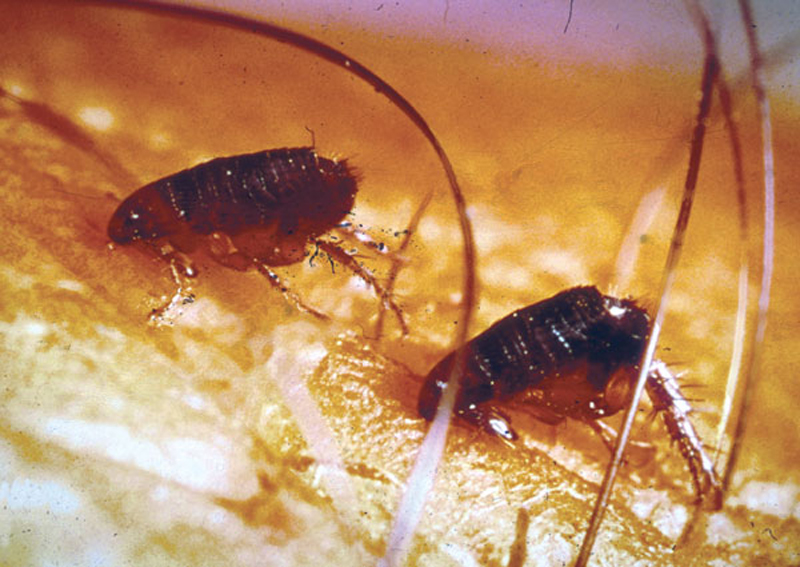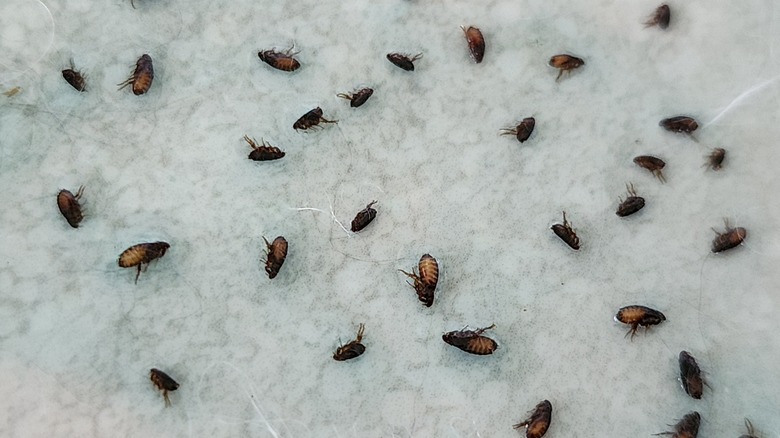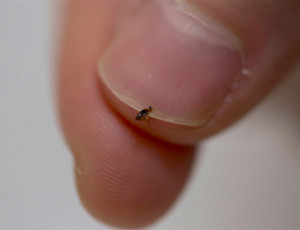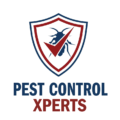Flea Treatments in Florida
Exterminator Services for Haines City, Lake Alfred, Winter Haven, Lake Wales, Davenport, and Polk City
Florida’s subtropical climate—characterized by warm temperatures, plentiful humidity, and moderate winters—creates near-perfect conditions for fleas to thrive. These small, wingless parasites feed on the blood of mammals, frequently targeting pets like dogs and cats. They can also bite humans when given the opportunity. For homeowners in Haines City, Lake Alfred, Winter Haven, Lake Wales, Davenport, and Polk City, fleas can quickly become more than a minor inconvenience if left unchecked. This service page explores why fleas flourish in Florida, the warning signs they are present, and why partnering with a professional flea exterminator is the surest way to regain a comfortable, pest-free environment.
Why Fleas Flourish in Florida

1. Warm, Humid Conditions
Fleas thrive in regions where temperatures hover between 65°F and 85°F, and moisture remains ample. Florida’s year-round warmth, supplemented by periodic rain, consistently meets these requirements. Because fleas lay eggs in shaded, humid areas—like lawns, gardens, or under porches—Florida’s climate allows infestations to persist. Even a brief dip in temperature generally doesn’t last long enough to significantly reduce flea populations.
2. Ample Wildlife and Pets
From household animals (dogs and cats) to local wildlife (raccoons, opossums, stray animals), Florida offers fleas an array of hosts. Pets that spend time outdoors or frequent dog parks, nature trails, or shared apartment lawns can easily pick up fleas and bring them inside, spreading the infestation around bedding, carpeting, or upholstered furniture. Once established, fleas breed rapidly, and ignoring them can lead to severe or widespread problems.
3. Outdoor-Indoor Transfer
Outdoor spaces, particularly where grass grows tall, remains damp, or accumulates yard debris, support flea development. Larvae hide in soil or within organic matter. When adult fleas latch onto a passing pet or hitch a ride on someone’s clothing, they gain access indoors—finding additional prey and sheltered, climate-controlled conditions in which to reproduce.
4. Longer Breeding Cycles
Unlike colder regions where frosts might kill off fleas or force them into dormancy, Florida’s mild winters typically permit fleas to reproduce through the year. This extended breeding season means a small number of fleas can mature into a large infestation quickly, as successive generations continuously emerge.
Telltale Signs of Fleas
1. Frequent Pet Scratching or Biting
A dog or cat that suddenly scratches, chews, or licks at its fur more than usual may be afflicted with fleas. Fleas commonly congregate around a pet’s neck, back, and hindquarters—areas where their bites are especially irritating. Prolonged or intense scratching can leave raw spots or hair loss if untreated.
2. Flea Dirt
Flea dirt refers to the dark specks of flea feces composed of digested blood. You may discover these on your pet’s fur, in bedding, or on carpets. When smudged on a damp paper towel, flea dirt often forms a reddish or brownish streak. Its presence points strongly to ongoing flea activity.
3. Visible Fleas
In heavier infestations, you may see adult fleas hopping in carpets or scurrying across pet bedding. Adult fleas are typically 1–3 millimeters long and dark brown to black, making them noticeable on light-colored surfaces. Because fleas jump rapidly, spotting them can be challenging until their population grows.
4. Bites on Lower Legs or Ankles
While fleas prefer animal hosts, they can bite people if given access. Flea bites on humans often appear as small, itchy red bumps concentrated around the ankles or lower legs—areas easily reached by jumping fleas. If multiple family members experience unexplainable bites, fleas may be the culprit.
5. Pet Behavioral Changes
Beyond itching, pets suffering from fleas might show restlessness at night or reluctance to settle in usual sleeping spots. Excessive grooming or grooming unusual areas might also be a clue. Observing these changes along with other signs often confirms a flea problem.
Risks of Ignoring Fleas
1. Rapid Population Growth
Flea eggs can hatch within a matter of days, producing larvae that transform into pupae and then adults. Because each adult female can lay dozens of eggs daily, a few fleas quickly expand into hundreds. Delaying treatment allows each life stage to cycle repeatedly, making eradication increasingly difficult.
2. Pet Health Issues
Severe flea infestations can lead to anemia, especially in kittens, older pets, or animals already weakened by other conditions. Pets with flea allergies may develop dermatitis—causing intense scratching, open sores, or infections. Managing these conditions might require vet visits, medications, or special diets, raising costs for owners.
3. Potential Diseases
Though less common than tick-borne illnesses, fleas can carry and transmit pathogens such as Bartonella (cat-scratch disease) or tapeworms to pets. For humans, flea bites can produce allergic reactions or secondary infections if scratched excessively.
4. Home Infestation Cycles
Fleas deposit eggs in carpets, rugs, or upholstery. Even if adult fleas on a pet are killed, hidden eggs may continue hatching if you don’t target the environment thoroughly. Flea pupae can remain dormant until triggered by vibration or warmth, producing waves of fresh adult fleas long after an initial treatment if not completely eliminated.
5. Discomfort and Stress
Beyond health concerns, a persistent flea problem disrupts daily routines. Constant itching, worrying about bites, or having to frequently launder bedding can strain households or undermine a business’s reputation (e.g., in pet-friendly hotels or rentals).

Why a Professional Exterminator Is Crucial
1. Comprehensive Inspection and Identification
A flea exterminator examines both indoor and outdoor areas—looking for eggs, larvae, or adult fleas in carpets, corners, pet bedding, or shaded yard zones. This thorough approach identifies the full extent of infestation, distinguishing fleas from other biting pests like ticks or bed bugs.
2. Multi-Stage Elimination
Killing visible adult fleas alone won’t stop the life cycle if eggs and larvae remain hidden. Professionals use insect growth regulators that prevent immature fleas from maturing, paired with adulticides to destroy current flea populations. This combined strategy halts ongoing reproduction and future outbreaks.
3. Safe, Effective Applications
Improper pesticide use can pose risks to people, pets, or beneficial insects. Certified exterminators apply targeted solutions, often focusing on baseboards, crevices, or yard edges while minimizing occupant exposure. They also provide guidelines on reentry times and precautions to ensure occupant safety.
4. Pet Care Coordination
While the exterminator handles the property, owners should consult a veterinarian about flea preventives, shampoos, or collars. This integrated approach—treating the environment and the pet simultaneously—cuts off fleas’ host options and speeds elimination.
5. Ongoing Support and Monitoring
Because flea eggs can hatch weeks after initial treatment, many exterminators schedule follow-ups or recommend ways to check for reemerging fleas. Vacuuming or laundering bedding regularly helps collect newly hatched fleas, while a quick re-spray or follow-up visit ensures no second wave gains traction.
Typical Methods for Flea Treatments
1. Inspection and Preparation
Before applying treatments, professionals assess problem spots—like sleeping areas for pets, thick carpeting, or yard patches. They might advise vacuuming floors, washing pet blankets on high heat, and removing clutter so insecticides can penetrate effectively.
2. Indoor Sprays and Dusts
Adulticide sprays and insect growth regulators address current adults and prevent larvae from becoming biting adults later. Exterminators treat floors, under furniture, near pet beds, and along baseboards. Occupants and pets may need to leave until sprays dry, ensuring safety.
3. Outdoor Yard Applications
If fleas breed in lawns, under porches, or in damp soil, yard treatments are vital. Sprays or granules targeting adult and immature fleas help cut down external populations. Trimming tall grass, raking leaves, and reducing yard clutter also make conditions less appealing to fleas.
4. Vacuuming and Steam
Flea eggs often hide deep in carpet fibers or upholstery. Vacuuming removes many eggs and larvae, preventing them from maturing. Steam cleaning rugs or furniture can kill fleas on contact, including pupae resistant to certain chemicals.
5. Follow-Up Visits
Because eggs can continue hatching for weeks, ongoing observation is essential. Exterminators or homeowners may place flea traps or keep checking pet behaviors. If new fleas emerge, professionals reapply treatments to kill them promptly.

Service Areas
Haines City
From suburban homes to rental cabins, Haines City’s mild climate supports steady flea activity. A professional flea exterminator detects and addresses indoor and outdoor hotspots, implementing thorough treatments. Pet-friendly neighborhoods especially benefit from routine checkups and yard treatments, ensuring families and their pets remain itch-free.
Lake Alfred
Known for its scenic lakes and calm residential streets, Lake Alfred offers plenty of yard space, but also more area for fleas to occupy. Pet owners appreciate fast, discreet flea solutions that keep them from tracking pests into living areas. Treatments combine yard checks, insect growth regulators, and vacuuming for lasting success.
Winter Haven
Between hosting visitors for its chain of lakes and serving local families, Winter Haven has plenty of pets and potential flea transfer points. Vacation rentals, dog parks, or communal apartment lawns can all harbor fleas. Professionals in Winter Haven swiftly eradicate infestations, protecting property values and occupant comfort.
Lake Wales
Lake Wales blends historical charm with an active outdoors scene. However, fleas quickly exploit any gaps in pet care or yard maintenance. By sealing indoor cracks, applying multi-stage treatments, and coordinating veterinarian advice for animals, property owners can prevent fleas from overrunning well-loved spaces.
Davenport
With its proximity to major tourist attractions, Davenport sees a steady stream of visitors. Hotels, Airbnbs, or rental homes risk unwanted fleas if incoming guests bring them unknowingly. For both commercial and residential sites, addressing fleas promptly ensures a comfortable environment, crucial for preserving Davenport’s hospitality reputation.
Polk City
Polk City’s peaceful neighborhoods and recreational areas are also prime spots where fleas latch onto pets or local wildlife. A professional exterminator applies targeted solutions, ensuring fleas that do arrive can’t establish robust populations. Consistent monitoring, particularly for households with multiple pets, keeps fleas from spreading.
Why Our Flea Treatments Excel
1. Florida-Centric Expertise
With years of combatting fleas across Florida’s subtropical zones, our exterminator team knows how climate and local wildlife patterns encourage flea life cycles. Adapting proven solutions to each region—Haines City or Lake Alfred, for instance—maximizes coverage for adult fleas and their future generations.
2. Thorough Inspection and Tailored Action
Every situation differs. Before we treat, we inspect both indoor furnishings and yard features, finding breeding spots or hidden egg caches. Then, we recommend a plan blending insect growth regulators, adulticide sprays, vacuuming, or yard improvements that aligns with your home or business’s layout.
3. Prioritizing Safety and Minimizing Disruption
Our technicians use professional-grade products in carefully selected areas, reducing occupant or pet exposure. We offer clear guidelines for reentry and pet reintroduction, ensuring minimal downtime. Our methods kill fleas swiftly while maintaining a safe living environment.
4. Integrated Pet Care Recommendations
Effective flea control typically involves both property treatments and veterinarian-approved pet regimens—like topical preventatives, oral medications, or special shampoos. We provide advice on grooming schedules, bedding laundering, and vacuuming routines, helping owners maintain results long after service.
5. Ongoing Assurance and Follow-Up
Many infestations require at least one follow-up as previously laid eggs hatch. We revisit if needed, ensuring no second wave thrives. This thorough approach, supplemented by occupant vigilance, keeps fleas at bay for the long run, sparing families from repeated itching and frustration.
Next Steps
If your pets are scratching persistently, you spot tiny black specks in carpets, or mysterious bites appear on your ankles, it’s time to act. Contact us to learn more or schedule your service. Immediate intervention halts the flea life cycle, preventing small issues from ballooning into large-scale infestations that compromise comfort and wellbeing.
Our flea treatments in Haines City, Lake Alfred, Winter Haven, Lake Wales, Davenport, and Polk City attack fleas at each stage—egg, larva, pupa, adult—using specialized methods that suit Florida’s environment. By combining rigorous inspections, safe but potent products, and guidance on pet management, we deliver relief from relentless itching and protect your home or business from persistent pest concerns. Trust our professional flea exterminator to reclaim your space from these aggravating parasites.
Maintaining a Flea-Free Environment
- Check Pets Often
Use a fine-toothed comb on your dog or cat, focusing around the neck, hindquarters, and belly. If fleas or “flea dirt” appear, consult your veterinarian. Prompt action keeps these pests from jumping around your home or yard. - Vacuum Thoroughly and Regularly
Flea eggs and larvae often hide deep in carpets or upholstered furniture. Vacuum floors, rugs, cushions, and pet bedding multiple times weekly. Dispose of vacuum bag contents outside in a sealed bag to prevent re-infestation. - Launder Pet Bedding on High Heat
Wash blankets, plush toys, or any fabrics your pets frequently use in hot water, then tumble-dry on high. This kills fleas and eggs. Keep extra bedding handy so you can rotate clean sets while washing used ones. - Maintain Yard Tidiness
Mow grass to a moderate height, trim overgrown shrubs, and rake leaves or debris—especially in shaded, damp spots. Fleas love to develop in moist soil. Without these protective hiding places, outdoor flea populations dwindle. - Seal Entry Points
Inspect door frames, window screens, or cracks in exterior walls for gaps. Though fleas usually hitch rides on animals or clothing, limiting direct openings also helps minimize other pests or wildlife from entering your property. - Adopt Preventative Pet Treatments
Speak to your vet about monthly or quarterly flea preventatives for your pets. Topical solutions, oral pills, or specialized collars can deter fleas from latching on. This combined approach—treating both pets and property—ensures more lasting defense.
By following these guidelines and arranging prompt professional help when needed, property owners across Haines City, Lake Alfred, Winter Haven, Lake Wales, Davenport, and Polk City can control flea populations, preserving a comfortable, pest-free environment. Florida’s climate may foster fleas year-round, but consistent vigilance—through frequent cleaning, responsible pet care, and specialized exterminator treatments—keeps fleas from taking hold, ensuring peace of mind and relief from the constant scratching or anxiety these parasites bring.
